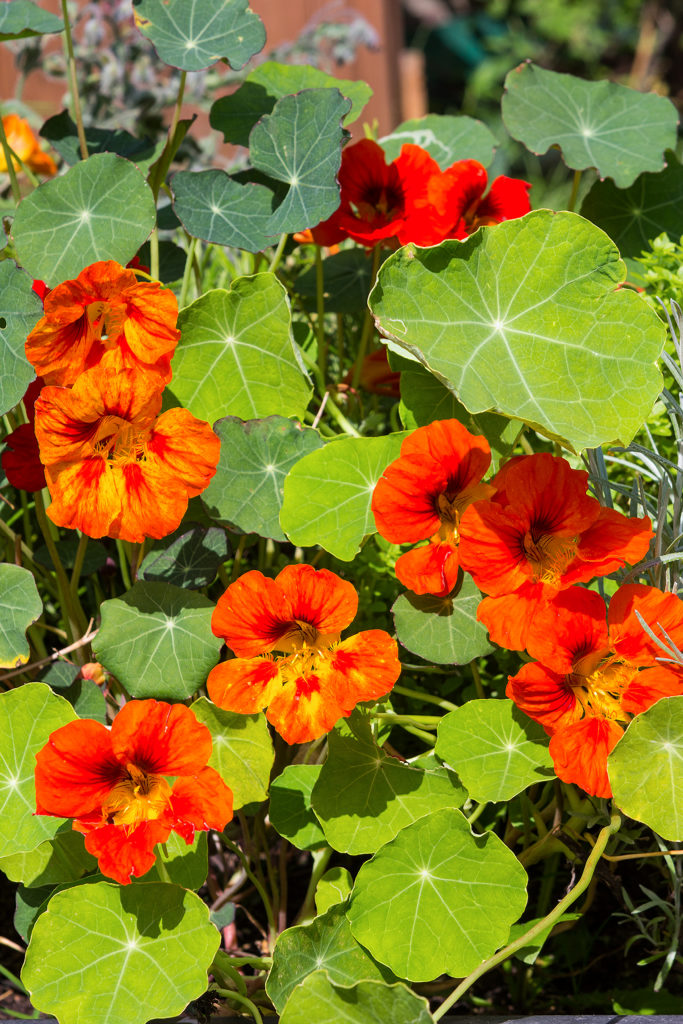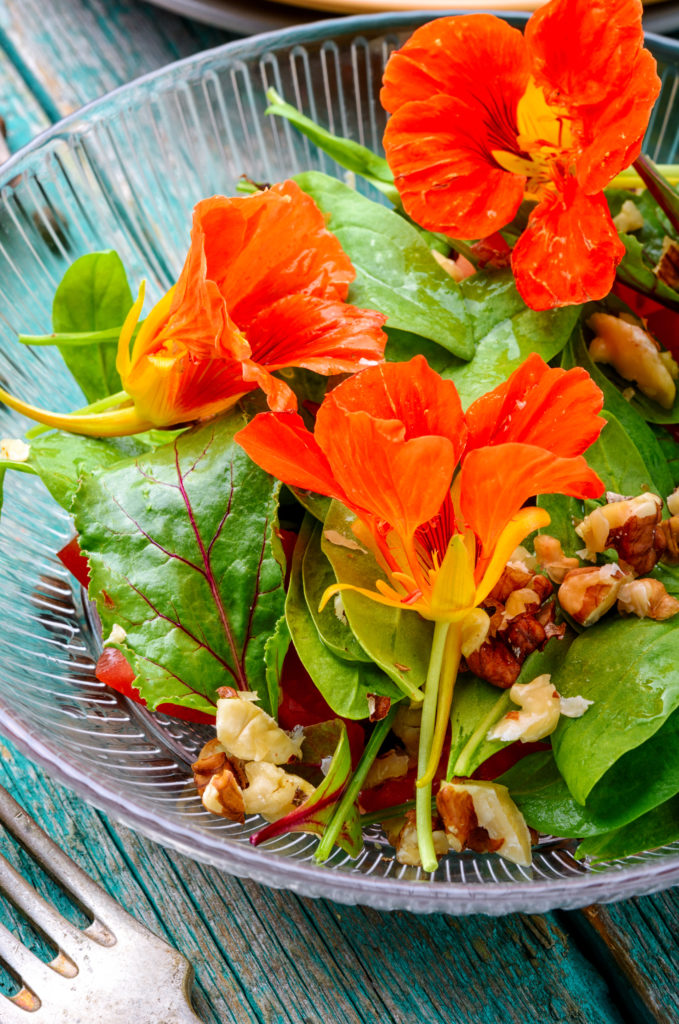Nasturtiums are grown in the flower garden for their array of bright colors. They are grown in the herb garden for their distinctly peppery flavor. All parts of the nasturtium are edible—the leaves, the flowers, and the seeds. The flavor of nasturtiums is similar to watercress.
Here is your complete guide to growing nasturtium.
Where to Plant nasturtium
- Best location: Nasturtiums prefer full sun; plants will survive in filtered shade but will not flower as well.
- Soil preparation: Plant in well-drained, moderately fertile soil; avoid too much nitrogen or there will be no blooms. Nasturtiums prefer a soil pH of 6.0 to 8.0.
Related articles:
- How to Start an Herb Garden
- Best Herbs for Container Growing
- Herbs for Cool Season Growing
- Grow 20 Herbs for Cooking

When to plant nasturtium
- Seed starting indoors: Start nasturtium seed indoors four to five weeks before the last spring frost. Soak seed overnight before sowing. Germination will take 8 to 12 days at 70° Start the seed in individual pots under fluorescent lights. Pot up plants when they are 4 to 6 inches tall.
- Transplanting to the garden: Transplant nasturtium seedlings after all chance of frost has passed; seedlings should have four leaves at transplant time.
- Outdoor planting time: Sow seeds in the garden after the last spring frost.
How to plant nasturtium
- Planting depth: Sow seed ½ inch deep.
- Spacing: Space nasturtium plants 12 inches apart.
- How much to plant: Grow 6 to 8 nasturtium plants for culinary use.
Companion planting nasturtium
- Companion planting: Plant nasturtiums with vegetables, strawberries, parsley, and sunflowers. Nasturtiums are said to repel whiteflies, cabbage pests, and squash bugs. Nasturtium flowers attract hummingbirds.
Watering and feeding nasturtium
- Watering: Keep the soil evenly moist; do not let the soil dry out. In hot weather, water at midday to keep nasturtium leaves from wilting.
- Feeding: Add a low nitrogen organic fertilizer to the soil at planting time such as 5-10-10. Too much nitrogen will result in green growth, not blooms. Feed nasturtiums with compost tea or a dilute solution of fish emulsion every few weeks during the growing season.
Nasturtium care and maintenance
- Care: Pinch back the growing tips if you want compact bushy plants; for longer vines do not pinch back the growing tips.
- Mulching: Mulch around nasturtiums with aged compost or a commercial organic planting mix to keep the soil cool and moist. Mulching will prolong blooms in hot weather.
Container growing nasturtium
- Container growing: Nasturtiums are easy to grow in containers or hanging baskets. Grow them as a potted annual. Add a slow-release fertilizer to the potting soil. Soak seeds in water for a few hours before sowing. Set containers in bright light, but not in direct sun when temperatures are hot. Keep the soil just moist; do not let it dry out.
- Winter growing: Nasturtiums can grow in a pot indoors in winter; grow nasturtiums in a bright window or under fluorescent lights.
Nasturtium pests and diseases
- Pests: Aphids and leafminers can attack nasturtiums. Knock aphids off plants with a steady stream of water. Remove leaves that show signs of leafminer tunnels.
- Diseases: Bacterial wilt, leaf spot, and verticillium wilt can attack nasturtiums. Avoid overhead watering; space plants so that they get plenty of air circulation. Remove diseased leaves or plants.
How to harvest nasturtium
- When to harvest: Pick nasturtium leaves for culinary use as soon as the plant is 6 inches tall. Pick flowers just as they open. Collect the green seedpods when they are just over ¼ inch in diameter.
- How to harvest: Cut leaves and flowers with their stems attached. Use a garden pruner or scissors. Remove old flowers to prolong the bloom period. To collect seeds, stop deadheading in late summer.
- xxx
Nasturtium in the kitchen
- Flavor and aroma: Nasturtium leaves and flowers taste spicy, almost peppery, with no noticeable fragrance.
- Leaves and flowers: Use young nasturtium leaves and flowers in fresh salads, sandwiches, or as a garnish. Add flowers or leaves atop steamed vegetables. Use flowers to garnish salads and cold soups such as vichyssoise.
- Seeds: Use preserved nasturtium seedpods as a substitute for capers in tartar sauces and spiced mayonnaise and with tuna and hard-boiled eggs.

Preserving and storing nasturtium
- Place fresh green seed pods in a heat-proof jar and pour heated vinegar over them. Let them cure for a week before using. Store in the refrigerator.
Nasturtium propagation
- Seed: Nasturtiums readily self-sow. Grow nasturtiums from seeds starting in early spring. The seed germinates in about 14 days.
- Cuttings: Root 6-inch cuttings in moist potting soil or in a glass of water at temperatures from 60° to 85°
Nasturtium varieties to grow
- There are many nasturtium cultivars to choose from; seeds are readily available at garden shops. Some varieties are trailing and others are compact and mounding.
- Tropaeolum majus has long stems that will trail over the ground or climb to 6 feet by coiling its leaf stalks around upright support.
- Tropaeolum minus is a compact, dwarf growing to about 15 inches high.
- ‘Alaska’ has yellow, orange, cherry red, salmon, and crimson flowers and variegated leaves.
- ‘Empress of India” has deep red flowers and dark green leaves.
- ‘Peach Melba’ has soft yellow, peach petals with a raspberry red throat.
- ‘Whirlybird’ has large flowers of many colors.
Get to know nasturtium herb
- Botanical name and family: Tropaeolum majus (Tropaeolaceae)—see nasturtium varieties below.
- Origin: South and Central America
- Type of plant: Nasturtium is a tender perennial grown as an annual.
- Growing season: Summer
- Growing zones: Nasturtiums grow in all zones when temperatures are 50° to 80°F; the best climate is Zones 3 to 9.
- Hardiness: Nasturtiums are killed by frost.
- Plant form and size: There are two nasturtium species—one bushy, and one climbing. The bush species grows 12 to 15 inches tall and wide; the vining species grow to 6 feet long
- Flowers: Nasturtium has broad, open, funnel-shaped five-petal flowers about 1½ to 2 inches across in colors from cream to brilliant reds, oranges, yellows, and bicolor combinations. There are single and double flower forms.
- Bloom time: Flowers begin to bloom in late spring and continue until the first frost.
- Leaves: Nasturtium has round, long-stemmed, shield-shaped, bright green leaves with wavy or slightly lobed margins; leaves can grow from 1 to 6 inches across. Long stalks are attached to the center of the leaves.
Also of interest:
- Anise
- Anise Hyssop
- Arugula
- Basil
- Bay
- Bee Balm
- Borage
- Calendula
- Caraway
- Catnip
- Chamomile
- Chervil
- Chives
- Cilantro-Coriander
- Clary
- Costmary
- Cress
- Dill
- Fennel, Sweet
- Horseradish
- Hyssop
- Lavender
- Lemon Balm
- Lemongrass
- Lemon Verbena
- Lovage
- Marjoram
- Mint
- Nasturtium
- Oregano
- Parsley
- Perilla
- Rosemary
- Sage
- Salad Burnet
- Savory
- Scented Geranium
- Shiso
- Sorrel
- Stevia
- Sweet Cicely
- Tarragon
- Thyme
Related articles:
Best Herbs for Container Growing
Planning the Home Fruit Garden
Garden Planning Books at Amazon:
- Vegetable Garden Almanac & Planner
- Kitchen Garden Grower’s Guide Vegetable Encyclopedia
- Vegetable Garden Grower’s Guide
- Tomato Grower’s Answer Book


















